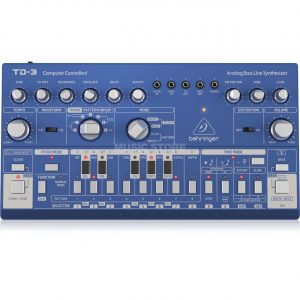Novation Peak
$926.99
Create captivating soundscapes and unlock your creativity with Novation Peak, the polyphonic synthesizer that allows you to explore a world of sonic possibilities!
Compare
Description
Novation Peak Synthesizer: The Future of Electronic Music Arrives
Novation has been bringing innovative tools for music producers for years, and the introduction of their newest synthesizer, Novation Peak, is a real game-changer. This stunning piece of machinery is a hybrid of digital and analog technology, making it stand out in the music industry.
With incredible sound capabilities, this collection of synthesisers and effects can rival some of the other big names in the music production world. Every aspect of the Novation Peak Synthesizer is carefully thought out to make it an iconic tool for creative musicians.
Control and Interface
The user interface of the Novation Peak Synthesizer is carefully constructed, with 8 rotary encoders that offer real-time control over its dual oscillators, 3 LFOs and modulation matrix. This helps to create a unique and high-quality synthesizer sound that is sure to awaken any music creativity.
The synthesizer is designed to resemble an amplifier with its neat black design, and a rather basic layout that is easy to use. The four OLED displays provide enough details to make the synthesizer easy to work with.
Hybrid Technology
As stated earlier, hybrid technology makes this synthesizer exceptional. It has a great combination of digitally controlled oscillators, along with circuit analog filters, which work together to create an awesome sound. This design creates plenty of possibilities for creating new and exotic sounds that are impossible with a purely digital synth.
Digital Control
Digital synthesizers can sometimes be weak in their sounds when compared to analog synthesizers. However, this is not the case with the Novation Peak Synthesizer. The double hybrid design allows it to use the best of both worlds, with the digital side controlling analog oscillators and filters for top-notch sounds.
Effects
The synthesizer’s effects are various and well-sorted. The onboard effects include distortion, chorus, delay, and reverb. The built-in FX is of high-quality, and their interface inherits the same aesthetic as the rest of the synth, and it is simple to use, making the process more fun and creative.
Conclusion
In conclusion, the Novation Peak Synthesizer is one of the best synthesizers available in the music industry. It packs a lot of features, making it an excellent tool for professionals, from the hybrid technology, digital control, great user interface and excellent onboard effects. And even for beginners, it is an excellent tool to learn how to produce high-quality and unique sounds.
However, its modulations can be a bit challenging to work with, and as you would expect, this synthesizer will cost you some extra money. But to summarize, the Novation Peak Synthesizer is a terrific tool that can bring a new dimension to music production, making the process an extraordinary experience.
Novation Peak properties
| Product name |
Peak |
| Brand |
Novation |
| Type |
Keyboard Instruments |
| Keyboard Instrument |
Synthesizer |
| Drawbars/Sliders |
Yes |
| Rotary Controls |
Yes |
Frequently Asked Questions:
What is the unique feature of Novation Peak that sets it apart from other synthesizers on the market?
The unique feature of Novation Peak that sets it apart from other synthesizers on the market is its innovative use of Bluetooth technology, allowing for seamless connectivity with a range of compatible devices and enabling users to control and manipulate their audio in new and creative ways. Able to run off either an AC adapter or battery power, Peak also features a high-quality LCD display that provides clear information about your current settings and menu options, making it easy to navigate and tweak your sound. Additionally, the synthesizer includes a variety of built-in effects, such as chorus, phaser, and tremolo, giving users the ability to add depth and character to their sounds. Overall, Novation Peak offers an intuitive and versatile solution for musicians and producers looking to expand their audio production capabilities and explore new creative avenues.
What are the unique features of Novation Peak's oscillator section and how do they contribute to its versatility as a synthesizer?
The Novation Peak synth boasts a powerful oscillator section with several unique features that set it apart from other synthesizers in its class. These features include:
1. Six oscillators: The Peak has an impressive six oscillators, which allows for rich and complex sound generation. Each oscillator can be individually configured with various waveforms, including classic shapes like sine, triangle, and sawtooth as well as more modern options such as wavetables and noise. Flexi mode: The Flexi mode in the Peak lets you create complex and dynamic sounds by synchronizing oscillators together. This allows for the creation of intricate rhythmic patterns and textures that would be difficult or impossible to achieve with traditional oscillator sync techniques. FM: Peak's FM (frequency modulation) capabilities go beyond what is typically found in synthesizers at this price point. With up to six FM algorithms available, you can create unique and complex sounds using the classic Yamaha-inspired technique or experiment with newer variations like ring modulation and ring modulation plus feedback. Oscillator morphing: Another standout feature is the ability to morph between two different oscillator states seamlessly, adding a degree of fluidity to your sound design process. All these features contribute to the Peak's versatility as a synthesizer by offering an incredible range of tonal options. Whether you prefer classic analog sounds or modern digital textures, you can achieve both and everything in between with ease. The Flexi mode and FM capabilities allow for advanced rhythmic patterns and unique sonic manipulations that are not typically found at this price point, making the Peak a compelling choice for serious synth enthusiasts looking for a powerful and versatile instrument.
How can I optimize the modulation matrix on the Novation Peak to achieve complex sound design techniques?
To optimize the modulation matrix on the Novation Peak for complex sound design techniques, follow these steps:
1. First, select the sound you want to work on and ensure it's loaded into one of the eight presets on the Peak. Next, access the modulation matrix by pressing the MOD button and selecting MATRIX from the menu using the encoder knob. The matrix displays 16 slots for routing sources (such as envelopes, LFOs, or sequencers) to destinations (such as oscillator frequencies, filters, or effects). To add a new modulation route, select an empty slot by pressing its number and then choose the source and destination using the encoder knob and navigation buttons. You can also use the SHIFT button to access more advanced options such as inverted, offset, or multiplied routing. Once you have added a few routes, you may find that some parameters are being modulated too strongly or not enough. To fine-tune this, select the slot containing the source and press ENTER to open its settings. Here, you can adjust the depth (how far it moves the destination), rate (how quickly it happens), and shape (how smoothly it transitions). If you want to create more complex routings or chains of modulation, you can use the SHIFT button to access more advanced options such as split, merge, or feedback loops. These allow you to route multiple sources to a single destination, or to chain multiple destinations together. Finally, don't forget that the Peak has a global envelope called GLOBAL EG (GEG), which can be used to modulate many parameters simultaneously. This is accessed by pressing ENTER on the MODULATION page and selecting GLOBAL EG from the menu. The GREG allows you to create complex rhythms, sequences, or evolving textures that can add depth and interest to your sounds. By following these steps, you'll be able to create rich, complex soundscapes using the modulation matrix on the Novation Peak. Experiment with different routings, source types, and destinations to find what works best for your particular style and goals.
What are the key differences between the Novation Peak's analog voice architecture and that of other high-end analog polyphonic synthesizers, such as the Roland Juno-106?
The Novation Peak, like its predecessors, utilizes a hybrid analog/digital signal path. In contrast to traditional fully analog synthesizers like the Roland Juno-106, which feature pure analog voice architectures, the Peak employs an architecture that combines both analog and digital components. One of the primary differences lies in the Peak's use of a DCO (Digital-to-Analog Converter) for its voltage-controlled oscillators (VCOs). This is in contrast to traditional synthesizers like the Juno-106, which utilize VCOs. The DCO technology used in the Peak allows for precise control over the frequency and pitch of the sound, offering higher stability and accuracy than traditional VCOs. Another significant difference is the Peak's implementation of a digital filter core. This digital filter offers a range of unique tonal characteristics that can be difficult to achieve with analog filters alone. The Juno-106, on the other hand, features an analog filter design which contributes to its distinct sound profile. Lastly, the Novation Peak incorporates a significant amount of processing power and computational resources within its architecture. This allows for complex algorithmic effects and signal processing techniques that can be achieved through digital means but are not possible with purely analog designs like the Juno-106. In summary, while both synthesizers offer high-quality sound generation capabilities, their architectures differ significantly due to the incorporation of DCOs, digital filters, and advanced processing power in the Peak.
Before you buy Novation Peak








Bennett –
As an avid music producer, I was excited to get my hands on the Novation Peak synthesizer. This product is a hybrid digital-analog synth that produces high-quality sound and has a range of features that make it an attractive choice for anyone looking to enhance their music-making experience.
One of the standout features of the Novation Peak is its rotary controls. These are highly intuitive and make it easy to adjust the parameters of your sounds. I found that I was able to make quick adjustments on the fly, allowing me to experiment with different sounds until I found the perfect tone.
However, there were also some downsides to the Novation Peak. While it has a lot of features, some of them are a bit confusing to navigate. It took some time to figure out how to access certain functions, and I found myself having to consult the manual quite often.
In terms of comparison to other synthesizers on the market, while the Novation Peak is a solid product, it perhaps doesn’t quite measure up to other models like the Moog Sub 37 or the Korg Minilogue XD. These models offer comparable sound quality and features, but with a more straightforward interface and a higher level of durability.
Overall, I rate the Novation Peak at three stars out of five possible. While it has some great features, it could benefit from some streamlining and a more intuitive interface to bring it up to the level of some of its competitors.